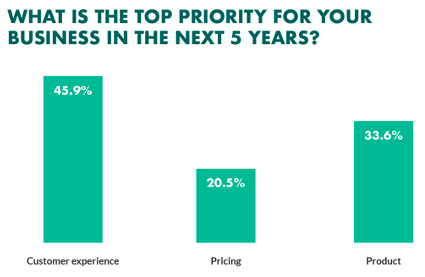
Click to learn more about author Gaurav Belani.
Customer satisfaction isn’t enough! To stay competitive and relevant, businesses need to create awesome customer experience (CX) that excites and engages their audience. Research shows that customers no longer base their brand loyalty on price or product quality. They value experience.
It’s no wonder CX is the top priority for most businesses for at least the next five years.
CX is a key differentiator for brands today. Creating stellar customer experience may include offering quality customer service, driving proactive customer engagement, building positive customer relations, and much more. The top brands excelling in the CX game can make the customer journey so seamless that their customers end up leading themselves to the value.

However, achieving all this requires a deep understanding of the customers, interactions, and underlying processes. Customer journey analytics helps marketers get valuable insights for delivering excellent experiences. It tracks and analyzes customer behavior across all touchpoints. It analyzes the way customers interact with and use a combination of channels to measure the performance of the CX initiatives.
CX is the driving force behind customer journey analytics. In this post, we’ll throw light on how marketers can adopt customer journey analytics to improve CX and boost customer retention.
But before that, let’s discuss customer journey analytics in detail.
What Is Customer Journey Analytics (CJA)?
As mentioned earlier, customer journey analytics is the process of tracking and analyzing how customers or prospects use various channels to interact with the organization.
It aims at helping businesses deliver optimal customer experiences across touchpoints by offering them 360-degree insights. These insights can be used by multiple functions throughout organizations, including marketing, sales, customer service, analytics, finance, and supply chain teams.
An organization with real-time CJA capabilities has clarity on the shifting customer interactions, thereby giving them a competitive edge. Moreover, these firms are more agile and offer relevant responses and experiences to changing customer needs.
Customer journey analytics incorporates three activities:
1. Journey Mapping involves understanding how customers are interacting with various touchpoints and channels. For instance, a journey mapping in a financial institution may discover that a subset of customers places a call to their financial advisor before purchasing an investment product.
2. Analytics involves effective visualization of journeys to unearth the events and customer attributes that boost conversion and engagement.
3. Orchestration filters the customer segments. It allows businesses to offer preferred actions, offers, and recommendations to their customers.
Customer experience begins with mapping customer journey to understand customers’ buyer journey behavior before they decide to make a purchase. Every step in the buyer journey has a motivator or a detractor.
For instance, when buying online from an e-commerce store, the product quality or special offers may motivate the shopper to make a purchase. But a slow site speed or complicated checkout process may detract them from buying the product. CJA can help in boosting your site’s experience by spotting issues early.
Finally, marketers should remember to align their SEO best practices with the buyer journey. Going back to the e-commerce store example, let’s say, the store using the BigCommerce platform applies all the SEO best practices to drive traffic to the site. In the absence of CJA, the firm will not be able to capture the potential customers in its funnel. Hence, SEO coupled with CJA can help businesses get the most out of their marketing efforts.
Tools for Effective Customer Journey Analytics
Today, it’s easy to facilitate the management and automation of the customer experience across all possible channels using the CJA software or the customer journey orchestration software. The tool tracks, weaves together, and analyzes customer interactions across all channels, allowing businesses to react in real time and execute behavior-driven strategies.
Platforms like Adobe Customer Journey Analytics, Insider, SharpSpring, and Glassbox can help firms better understand the wants and needs of their customers. These tools can orchestrate and optimize customer interaction and engagement through their journey.
Digital adoption platforms (DAPs) also can help marketers build better customer relationships through personalized and messenger-based experiences across the customer journey. DAP analytics can enormously help businesses, whether their customers are surfing their website or using their digital products.
DAPs can transform your user engagement levels. They help in tracking each user’s behavior, monitor the adoption of the key processes and features, and discover why customers dropped off during important processes.
Cloud-based interactive in-app guidance and engagement platforms help marketers measure and optimize user and customer engagement levels. They also help them gain insights into the entire customer journey, product adoption, and customer engagement.
How to Use CJA for Improving Retention
All successful enterprises are using customer journey analytics to attain real business impact. Here’s how you can use CJA to improve your customer retention and bottom line.
1. Use Analytics to Assess Customer Behavior
Customer journey analytics is often used by data-driven marketers to identify critical customer journeys and define apt KPIs for measuring each journey. It also helps marketers go a step further and answer complex questions that offer deeper customer insights.
- What’s the customer’s goal?
- How does their goal align with the organizational goals?
- Why are the customers behaving in a specific way?
- How does the customer journey impact business outcomes?
- Are there any actions or journeys taken in the past that have led them to this point?
- What other paths can a customer take? What are the most likely outcomes of the journey? How will it impact the business?
- How can the firm add value for each customer?
The answers to these questions can help marketers to make journey-driven decisions and create relevant experiences, thus winning the loyalty of their customers.
2. Measure and Improve Customer Experience
CJA makes it easy for marketers to analyze end-to-end journeys across channels. A few CJA tools leverage the latest technologies like AI and machine learning to quickly spot the root causes of CX issues.
Such insights can support organizations in adopting a customer-centric approach and boosting their overall CX outcomes. Teams can come together for planning and executing customer experience and ensure that relevant and consistent communication is delivered to customers at each stage of the journey.
3. Track the Behavior Indicators That Signal Churn
CX teams in most firms leverage customer journey analytics to measure journeys that result in the highest volume of churn and the drivers of churn.
First, the team uses CJA to spot CX issues across all channels that could lead to churn. Next, they analyze the issues that are driving a significant portion and velocity of the churn and revenue loss. Armed with this information, the team can prioritize issues to address them and reduce the churn.
Customer journey analytics can offer insights that can help you determine the areas of CX that demand immediate attention and optimization. Leverage it to reduce churn and boost customer retention.
Summing Up
Customer journey analytics allows marketing, sales, and other support teams to manage and track cross-channel customer journeys. This enables them to boost their online experiences and customer retention. All top-performing firms are using CJA to unlock valuable data across the entire buying cycle and increase the ROI of their retention efforts. Use the information shared in this post to improve the quality and effectiveness of your interactions and boost your retention rate.
